Latest arts reviews: Konstantin Shamray, Musica Viva, Objekt
Read the latest reviews from The Advertiser’s team of critics, including Konstantin Shamray, Musica Viva and Australian Dance Theatre’s Objekt

Arts
Don't miss out on the headlines from Arts. Followed categories will be added to My News.
Konstantin Shamray
Elder Hall
September 25
Konstatin Shamray’s piano recital provided a tale of two halves starkly contrasted with each other. Before interval, his program comprised an unrelenting contest between seemingly diabolic and divine forces with no guarantee of the outcome.
Nikolai Myaskovsky’s turbulent Sonata in C minor Op 19, unsurprisingly written in Russia of the 1920s, set the tone with emotional outbursts of the most chromatic romantic kind.

A Liszt bracket maintained the conflict, dominated by his Dante Sonata, a work guaranteed to test the resources of any piano with its subterranean rumblings and feverish torrents of octaves.
While Shamray’s prodigious technique handled all challenges with brilliance and immense power one must also say he was palpably eager for the fray.
Following interval, peace descended and all demons had apparently been banished as Shamray propelled his way through five of Rachmaninov’s best Preludes, catching the extremes from soaring lyricism to shimmering delicacies in an admirably architectural manner, eschewing sentiment and often producing astonishing pin-drop pianissimos.
But the find of the evening was undoubtedly Hindemith’s 3rd Sonata which closed the program in an entirely different vein.
Regarding himself as heir to the German tradition, and at home with contrapuntal writing and neo-classical objectivity, Hindemith had also achieved a degree of warm lyricism by 1936. This was evident in spades throughout Shamray’s deliciously animated, multi-shaded interpretation from its pastoral 1st movement to its sprightly final Fugue.
After all the tribulations of the program’s first half, this proved a breath of fresh air to be savoured.
– RODNEY SMITH
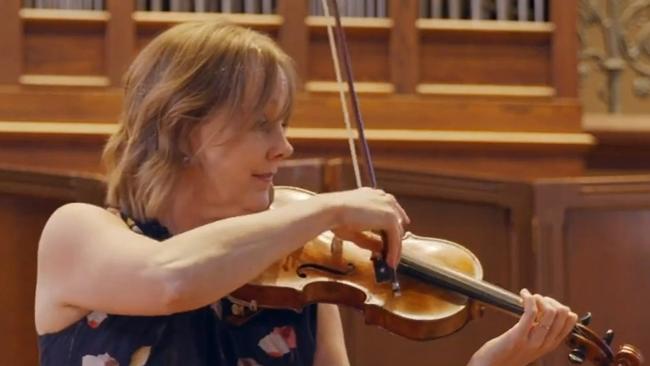
Musica Viva
Adelaide Town Hall
September 22
It’s a commonplace that live music of every kind has been dealt a body blow by the pandemic.
Perhaps no more so than touring outfits like Musica Viva, with its highly mobile rota of national and international artists.
This time it was the Goldner Quartet that found itself locked down, but in a reminder of the riches Adelaide audiences have on their own doorstep, a superb substitute was formed in the persons of Cameron Hill (violin), Helen Ayres (violin), Stephen King (viola), Simon Cobcroft (cello) and Konstantin Shamray (piano).
In just a couple of weeks, they prepared most of the advertised program, and gave performances that would do any established ensemble proud.
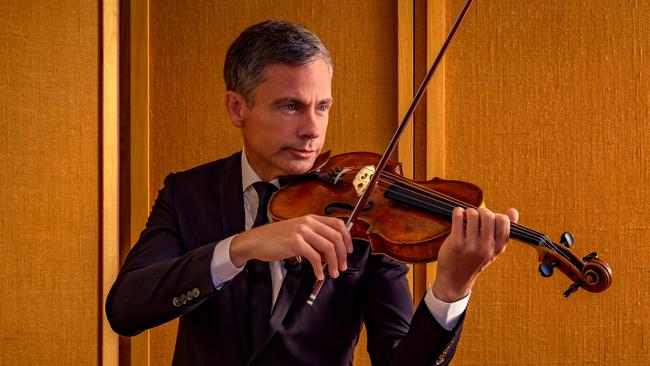
The concert was to include the world premiere of Adelaide’s own Jakub Janowski’s String Quartet No. 1, Kairos, commissioned by Adelaide supporters for the tour.
That will have to wait, but Peter Sculthorpe’s beguiling String Quartet No. 15 was a fine substitute. Violist King admitted to a long connection with this 1999 piece, having himself played in the world premiere.
The four string players all have deep experience with Sculthorpe’s work.
The 15th quartet looks further afield from Sculthorpe’s regular field of inspiration – the Australian landscape – across the Torres Strait to our northern cousins, and is rather more subtle than many of his other works in this form, with the notable exception of some overt birdsong in the lovely fourth movement, A Love Song.
Dvořák’s “American” String Quartet No. 12 in F major from 1893 is a hardy perennial in the chamber music world, and the four strings might have been playing together for years, so assured was their performance.
It’s a gorgeous piece, with its folksy opening, poignant second movement, danceable scherzo and driving finale, with hints of a stream train barrelling along the plains.
Brahms’ Piano Quintet in F minor (1864) is a monument of the repertoire and, joined by Shamray, the group once again played with absolutely confidence and deep understanding.
A measure of their security was the execution of the many sudden changes of tempo, especially in the expansive first movement.
The third movement with its memorable martial passages had many a finger tapping along (out of time, mostly).
The finale begins slowly (“gropingly”, as one writer delightfully puts it), but builds into one of Brahms’ most fiery, passionate sequences, tying the whole work together very satisfactorily.
– PETER BURDON

Objekt
Australian Dance Theatre
Dunstan Playhouse
September 13–19
It’s a mark of the strength of Garry Stewart’s Objekt that so much of it remains instantly recognisable five years after its local premiere.
Australian Dance Theatre prepared the work for revival in 2020, and even managed a one-off showing, but the pandemic put paid to that.
So now, another year on, Objekt returns to the stage in all its provocative glory.
There’s not a lot to celebrate in our modern world; the dark has eclipsed the light more often than not in recent years.
Stewart has not been one to shy away from controversy in the subject matter that inspires his creative output, and in Objekt, particularly when reflecting on objectification, with all its degrading import, he expresses himself very stridently indeed.
Set in three broad acts, the first is detached, revelling in the body for its own sake, an impression reinforced by the hooded, faceless dancers.
Signature moves featuring prominently, like the fast scampering on tip toes, and the razor-sharp alignment to Brendan Woithe’s dramatic, driving – and loud – score.
In the second part of the work, the dancers are revealed as flesh and blood creatures, in unisex leather-look shifts.

They’re not, however, granted the privilege of personification, for any attempt at individual or personal characterisation is roughly, often brutally put down. There are glimpses of hope, but they’re the preserve of nature.
Humankind really doesn’t seem to stand a chance, so strong is the drive to turn on each other.
The final section brings this into stark relief. Oppression and repression take hold, Nuremberg-like red flags are waved, a charismatic leader plays the crowd like puppets.
The closing sequence sees an echo of the anonymous figures from the beginning of the piece walled up in an act of ultimate repression.
Objekt is not for the faint-hearted, and was clearly a bridge too far for some. That said, it’s one of Stewart’s most memorable works, which is saying something.
– PETER BURDON
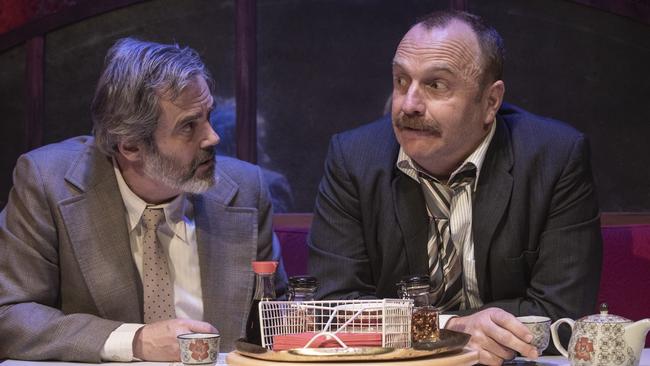
Glengarry Glen Ross
Bakehouse Theatre
September 10-25
David Mamet’s Pulitzer Prize-winning Glengarry Glen Ross is a gripping spectacle of desperate middle-aged men competing to sell real estate in a recession.
Failure is not an option. They will do anything, trick anyone, lie, and even steal. Nothing matters but closing the deal.
In the nearly 40 years since its debut, society’s patience for uber-machismo sprays of this kind has waned, so it’s a mark of the piece’s greatness that it remains a landmark in contemporary theatre.
David Mealor’s production for his Flying Penguin Productions, in association with Brink Productions, is nothing short of superb, bringing the story and these truly awful people to life in the most vivid, vicious way.
It’s almost inimical to single out particular characters, so strong is the ensemble cast, but mention can rightly be made of Mark Saturno’s Richard Roma, the high-achieving hot-shot, and Rory Walker as Shelly Levene, his mentor, but no longer the top dog.

Bill Allert as the office manager may not be selling dodgy real estate, but he’s every bit as unscrupulous, and devious to boot.
This was to be the 15th anniversary production for Mealor’s much-lauded company. Thanks to the pandemic, it’s 15 plus one, but still a very happy anniversary indeed for a company that’s a jewel in the crown of Adelaide’s vibrant theatre scene.
– PETER BURDON

Good People
Arts Theatre
September 2-11
US playwright David Lindsay-Abaire has had no fewer than three local premieres inside 12 months. State Theatre’s production of Ripcord was a wild ride; Joh Hartog’s Rabbit Hole was a worthy account of the Pulitzer Prize winner; now the Adelaide Repertory Theatre tackles Good People.
The good people of the title are the stoic inhabitants of Southie, working class South Boston. The lead character, Margaret, has just lost her job and the debts are mounting, and she’s forced to take drastic action.
Like Lindsay-Abaire’s Rabbit Hole, there’s a dark shadow hanging over Good People. Margaret may be long-suffering, but her tolerance is waning.
A lifetime of caring for her disabled child, now a grown woman herself, has dreams of what might have been would have been unimaginable in the past.
A chance encounter with a school fling who’s made good, now a prosperous doctor, sets in train a seemingly unstoppable chain of events.
As Margaret, Rachel Burfield gives a bravura performance. With scarcely a moment offstage, she inhabits the character, at once redeemed yet longing for redemption.
She is the glue that binds the whole show together.
The remainder of the cast acquit themselves admirably. As the old flame Mike, Nicholas Bishop gives a nuanced performance, outwardly middle class but with the Southie roots not entirely buried.
Margaret’s landlady, Dottie, is a very eccentric character, played for keeps by Lyn Crowther.
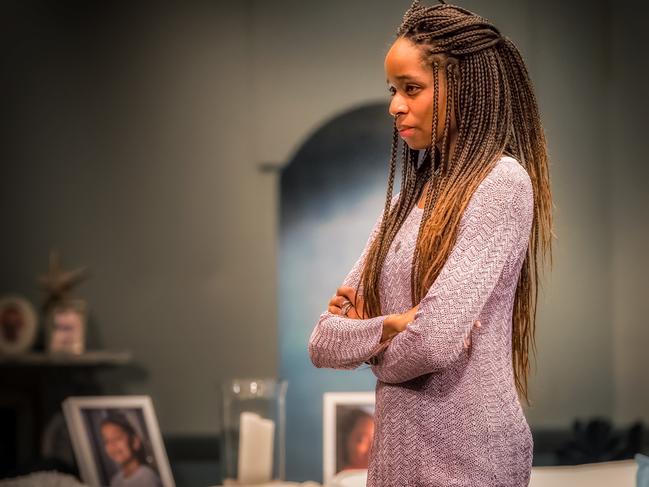
Rhoda Sylvester has a difficult part in Kate, Mike’s wife, who’s not above a bit of tough talking when needs must.
Another lifelong friend, Jean, eyeing off an opportunity with malice aforethought, is played chillingly by Cate Rogers. Rounding off the cast is Stevie, the son of yet another school friend – they stick together in Southie, except for Mike, of course – in a subtle account by Curtis Shipley.
Nick Fagan directs the production with his customary skill.
I remarked of Rabbit Hole that Lindsay-Abaire’s great achievement is to work so powerfully with the mundane. He does it again in Good People.
– PETER BURDON

The World Is Looking For You
Space Theatre
September 1 to 4
Adelaide is lucky to count, among its fine local artists, playwright Finegan Kruckemeyer, now firmly established among Australia’s best and most prolific playwrights. To have not one but two premieres of his work in just a month is a real treat.
A few weeks ago there was the astonishing Hibernation for State Theatre South Australia. Now, the Festival Centre’s inSpace program and Control Party, in partnership with Country Arts SA and Brink Productions, present The World Is Looking For You.
At the heart of the work is actor Sarah Brokensha, another homegrown product, whose award-winning company The Misery Children (the predecessor of Control Party) has created some amazing immersive theatre. She and Kruckemeyer go back half a lifetime, to his first commissioned work, and with this deep knowledge of one another, they are ideally matched to bring a vision about being lost – or being allowed by society to become lost – and being found once more.
This is told through the eyes of three very different women. One is Sarah herself, very direct, at one with the audience. Her loss was, and is, that of her father, with whom she had, and has, a visceral connection.
Another, the most theatrically “conventional”, is trying to forge a new life after a difficult separation, yet even now she seems to be unnoticed by the world around her. The third is a troubled soul, whose flights of dangerous fancy seem certain to end in disaster.
The genius of Kruckemeyer’s script is to drop in and out of the three strands without dislocation or confusion, and for the end of one to be the pivot to the next. The genius of Brokensha’s performance is to bring such a disparate trio to life.
Music is integral to the performance, a near continuous underscore from Mario Späte and Paige Court. It’s moody, and sometimes languorous, but is undeniably very effective.
The direction from Daisy Brown – another long-term collaborator with the team, and the deep connection shows – is spot on.
– PETER BURDON
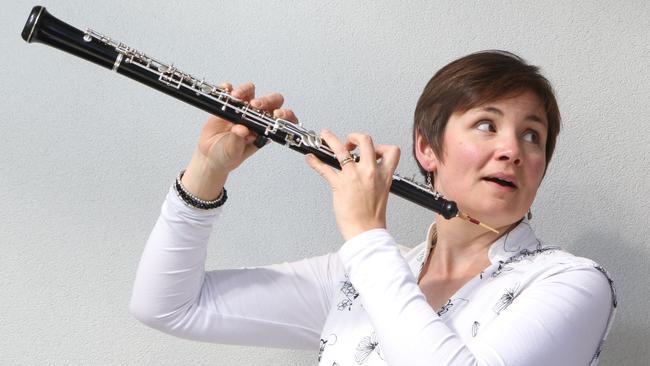
Musica Viva presents Celia Craig, Dean Newcomb, Mark Gaydon and Michael Ierace
Adelaide Town Hall
August 26
Woodwind chamber music is dominated by 20th century French works, and Musica Viva’s latest offering demonstrated the richness and variety within this genre.
Due to the current Covid-19 restrictions, Thursday’s concert was a late change from Queensland-based Ensemble Q to a program from some of Adelaide’s exceptional local performers: oboist Celia Craig, bassoonist Mark Gaydon, clarinetist Dean Newcomb and pianist Michael Ierace.
But there was no hint of hasty preparation, with vibrant playing throughout this well-conceived and engaging program.

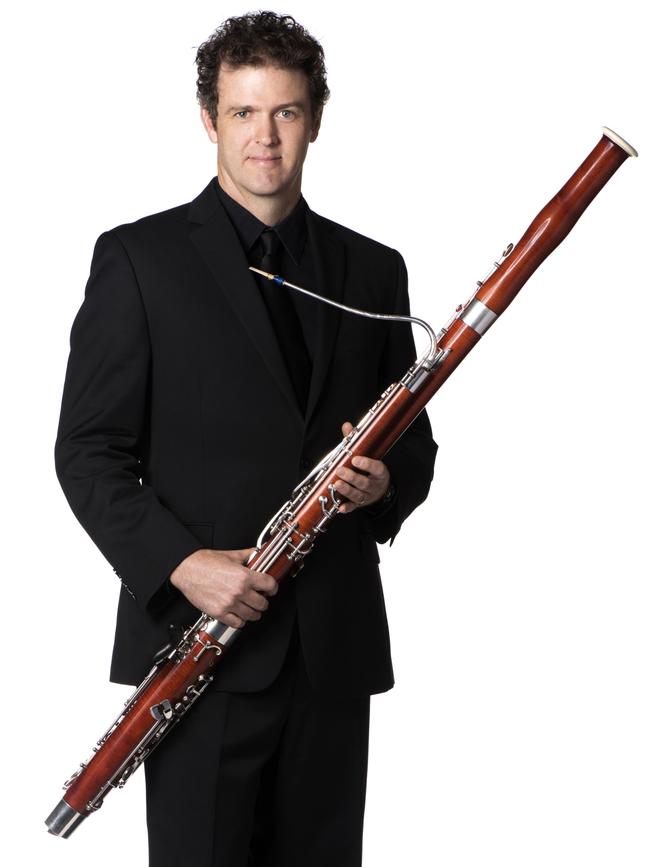
The standout work in the program was Camille Saint-Saëns’ sublime Sonata in D Major for oboe and piano. Craig brought out a breathtaking array of tone colours in this piece, and navigated its virtuosic demands with effortless precision.
Francis Poulenc’s music is a common feature in woodwind recitals. This concert featured not one, but two of his works – the Sonata for clarinet and bassoon, and the Trio for oboe, bassoon and piano.
Gaydon and Newcomb showed excellent attention to detail in the Sonata, with lyrical, nuanced phrasing in the second movement.
The concert also included Erik Satie’s solo piano pieces Gnossiennes No. 3 and Sonatine Bureaucratique. The latter is a parody of a well-known Clementi sonatina, and Ierace brought out its humour and wit to great effect.
Finishing off the program was Germaine Tailleferre’s Sonate Champêtre from 1972. This was most likely the Australian premiere of the work; it’s a shame that it took half a century for such a fantastic piece to reach an Australian audience.
– MELANIE WALTERS
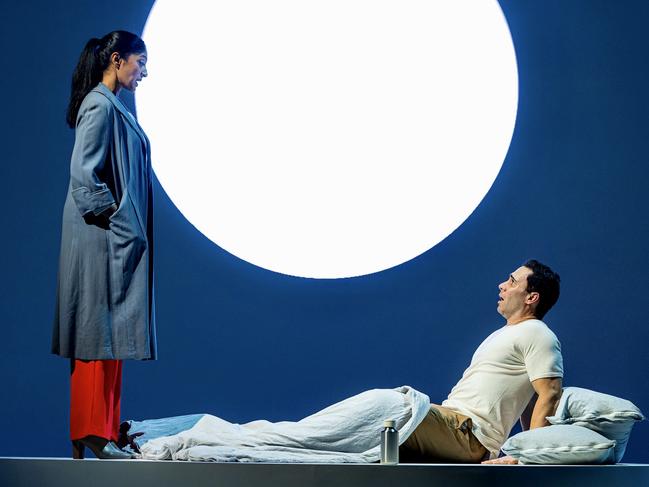
Hibernation
State Theatre Company South Australia
Dunstan Playhouse
August 13-28
No-one except a few indolent, ignorant politicians really doubts that climate change is real, but it remains an uphill battle to secure the traction needed to do something about it.
At the end of the day, it’s all in the sell.
And it’s with a headline-catching deal, tailor made for political pointscoring, that Finegan Kruckemeyer’s Hibernation begins.
In the face of impending disaster, science seems to provide the solution. Allow the entire human population to go into hibernation for a year, giving nature a chance to catch up. Properly sold, it’s an offer too good to refuse.
Integrity and artifice collide as politicians and influencers vie for attention, but the voiceless are not forgotten, from a Lagos slum to a strata apartment in Bogotá.
The first and third acts of this sprawling story canvas the making of the decision, its implementation, and after the event, its effects.
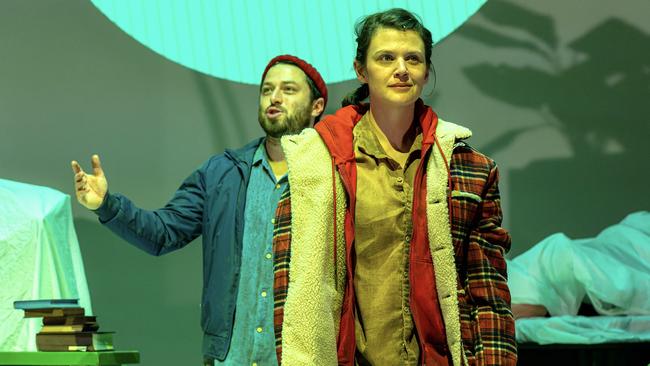
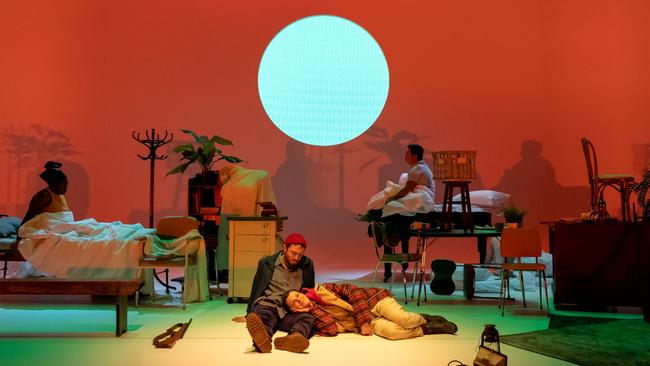
It is in the second act, a two-hander for Pete (James Smith) and Maggie (Elizabeth Hay), when the piece really hits home. Taking place during Hibernation, where just a few seem not to be affected, it is set firmly and squarely in Adelaide, with its familiar sights, albeit with wild animals now roaming the deserted streets.
The performances from Smith and Hay are simply the best of a uniformly excellent company. Mark Saturno is a brilliantly oily politician, and Ansuya Nathan an ambitious researcher – indeed, the architect of Hibernation – who develops an evangelical fervour as times goes by.
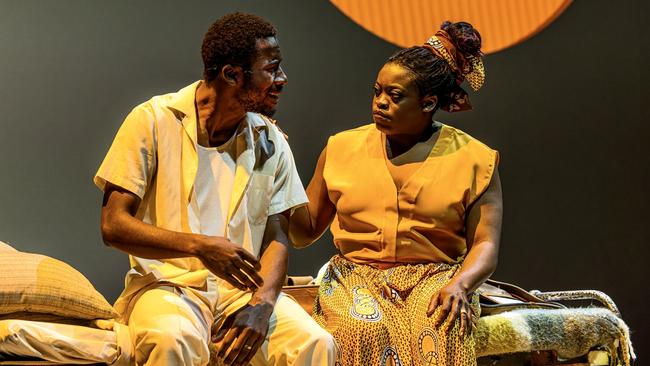

In the dual roles of a US TV anchor and an aged Colombian mother, Rosalba Clemente is miraculous.
Mitchell Butel has done a mighty job in directing this expansive piece, and is very ably supported by Jonathon Oxlade’s superlative design – this is one of the most beautiful shows we’ve seen for some time – and Gavin Norris’s well-judged lighting.
Hibernation invites the audience to think seriously about one of the most difficult issues we human beings have brought upon ourselves in such a short time. And time is marching on.
– PETER BURDON
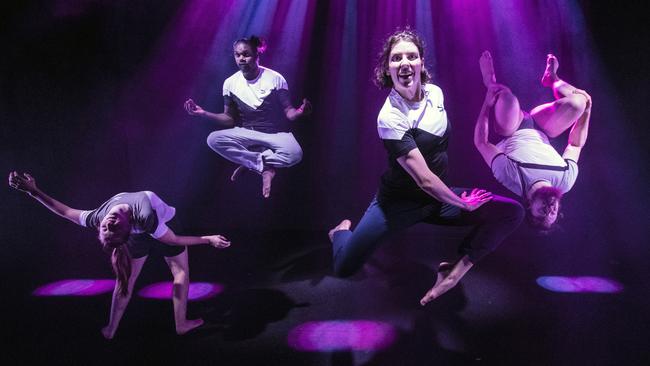
I Wish …
Space Theatre, until August 28
Touring regional SA until September 23
Book at patchtheatre.org.au
I Wish … is a collaboration between two renowned Adelaide companies, Patch Theatre and Gravity & Other Myths, and is a delicious blend of Patch’s unrivalled rapport with young children and GOM’s astounding acrobatic skill.
Designed for children aged 4-12, I was lucky enough to catch a schools performance at which the audience was almost entirely made up of five-year-olds.
Their unfiltered response made for a fantastic gauge of a work’s success, which I Wish … is.
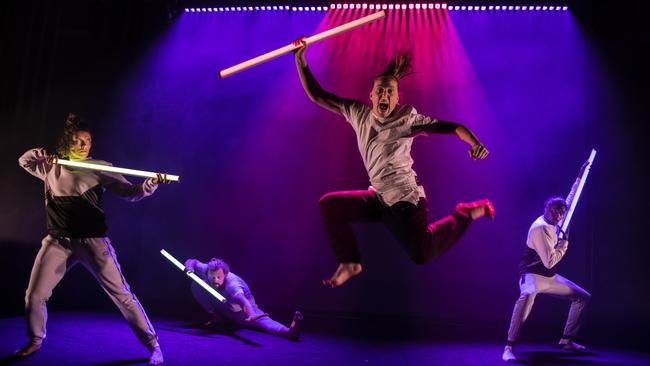
It’s full of the hi-tech gizmos that have made Patch’s recent work such a revelation for the inquiring theatregoer, but for the kids it was straightforward: Primary colours plus green, lights off (hush), lights on (shout), jumps and rolls (ooh!) and the occasional embarrassing noise (wild laughter). Basically, a whole lot of fun.
The title, I Wish … pretty much sums it up. Even if you can’t do anything you want, or be anything you want to be, you can wish. I want to be a volcano! I want to do a big burp! I want to fly! I want to roll on the ground!
And I’d wager a guess that there’s a couple of hundred kids who want to be acrobats right now.
For many of the tots at the performance, it was their first time ever in a theatre. “It’s like a bus,” said one.
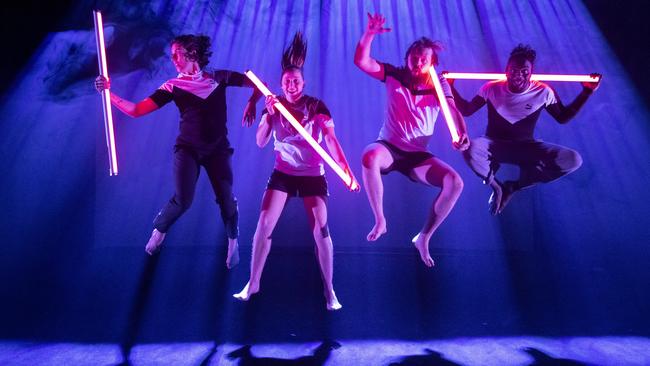
Thanks to a top-shelf creative team including co-creators Geoff Cobham and Darcy Grant, designer Michelle “Maddog” Delaney, composers Luke Smiles and Will Spartalis, animator Luku Kuku (fantastic creatures) and especially performers Zoë Dunwoodie, Lisa Goldsworthy, Wakara Gondarra and Simon McClure, they discovered a world of wonder.
They’re the audience of the future, and they’ll be back.
– PETER BURDON

Symphony Series 4
Adelaide Symphony Orchestra, conducted by Nicholas Braithwaite
Adelaide Town Hall
August 12 to 14
This concert was notable for something that happened and something that didn’t happen.
What happened was the concert itself, something of a miracle in this age of pandemic uncertainty which has cut such a swath through the performing arts that I can’t help wondering, in darker moments, whether they will survive.
It is very much to the credit of the ASO – its management and players – that they have survived and been able to present concerts, maybe not as originally planned, and to reduced audiences, but concerts nonetheless.
For the many people who have been starved of live performances, every opportunity is welcome.
What didn’t happen was that nobody applauded after the third movement of Tchaikovsky’s 6th Symphony. This non-event was notable because the seemingly triumphant ending of this movement has deceived audiences for more than a century.
I remember the tumultuous applause it received in Adelaide when performed by the New York Philharmonic under Leonard Bernstein in early ’70s. I felt embarrassed at the time as it seemed to prove that Adelaide, as I suspected at the time, was a hick town.
Be that as it may, we have clearly grown in sophistication. Nobody could accuse Tchaikovsky of subtlety – in this performance veteran conductor Nicholas Braithwaite went for broke, which is really the only way to do it, and the result was powerfully impressive.
Earlier in the program we had Wagner’s magical Prelude to Lohengrin, with its sublime, ethereal opening for high strings beautifully played.
That was followed by Mozart’s rollicking Haffner Symphony. Whether by accident or design, both the Mozart and Tchaikovsky were performed for the first time by the ASO 80 years ago in 1941, under the baton of Bernard Heinze, in the midst of another crisis – World War II.
– STEPHEN WHITTINGTON

Blithe Spirit
University of Adelaide Theatre Guild
Little Theatre
August 11 to 21
Much of Noel Coward’s work – and life, for what it’s worth – has been described as “frivolous with a tinge of cynicism,” and this sums up the perennially popular Blithe Spirit to a tee.
Charles Condamine is a novelist with a case of writer’s block.
At the suggestion of his socially-conscious wife Ruth, he agrees to an ill-conceived cocktail-party-cum-seance where a muddle-headed medium, Madame Arcati, summons his late wife Elvira back from the dead.
Elvira is funny, needy and manipulative, and not necessarily in that order.
Megan Dansie’s production for the University of Adelaide Theatre Guild is impeccably tailored, with not a thing out of place from the tongs in the ice bucket to the nasturtiums on the side table.
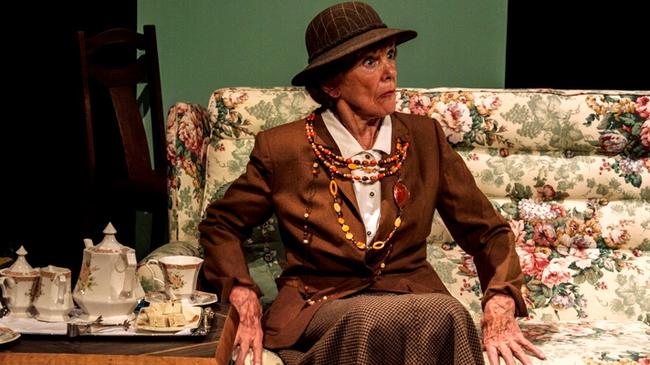
And there are some nice characterisations. Brad Martin is an urbane Condamine, and Jean Walker a most entertaining and eccentric Madame Arcati. Miriam Keane brings to Ruth Condamine a forced self-assurance, as if the niceties of the middle class are yet to settle.
Emily Currie as Elvira, the late Mrs Condamine, is very much the cheerfully indifferent blithe spirit of the title.
Well-intentioned though it all is, the production ultimately fails to fire. Martin’s Condomine and Walker’s Madame Arcati are great fun, but the other characters are thinly drawn.
Currie vamps it up, but in the all-important scenes with Condamine and his two wives, the balance is askew.
They need to take Madame Arcati’s advice: “Steady rhythm – that’s what does it!”
– PETER BURDON
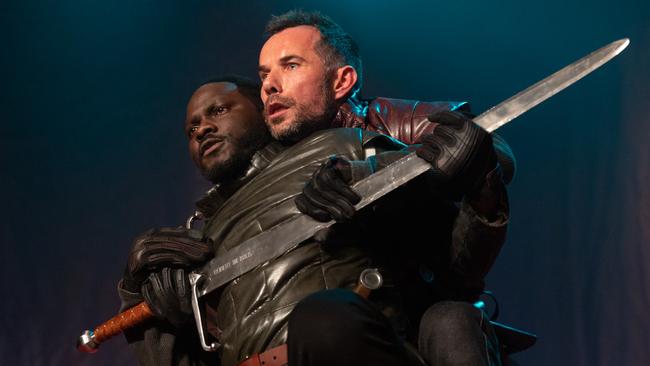
Macbeth, by Independent Theatre
Goodwood Theatre
July 31 to August 7
With a short, sharp lockdown calling everything into question at the eleventh (if not the witching) hour, the enormous cast of Independent Theatre’s Macbeth were both revelling and relieved at giving life to director Rob Croser’s take on Shakespeare’s darkest tragedy.
Anything that starts with a prophecy from three cackling witches can’t end well, and sure enough, the merest hint is enough to send the titular warrior-general headlong into his doomed quest.
And what a quest it is, and what a performance from Matt Hyde, in the title role, who owns the stage from the get-go.
Hyde genuinely gets theatre, and he inhabits the character, giving a finely nuanced performance ranging from the smallest aside to anguished cries.

Among the other leads, Rebecca Kemp as Lady Macbeth gives a performance of like finesse, many-layered and broadly drawn, and a real piece of work.
Steve Turner is terrific as the ill-fated Banquo, while Shedrick Yarkpai’s Macduff is also on a grand scale.
Many of the players do multiple duty in the couple of dozen other roles in this complex piece, and more than a few of the minor roles were over-egged, but the adoring audience in the Covid-limited house lapped it all up.
The set, from David Roach and his stalwart band, is a triumph, a steep diamond-shaped rake in blood red, adding to the atmosphere that pervades the piece.
The company has been able to secure some additional performances to take the reduced house into account, so there’s no excuse not to get along.
– PETER BURDON


